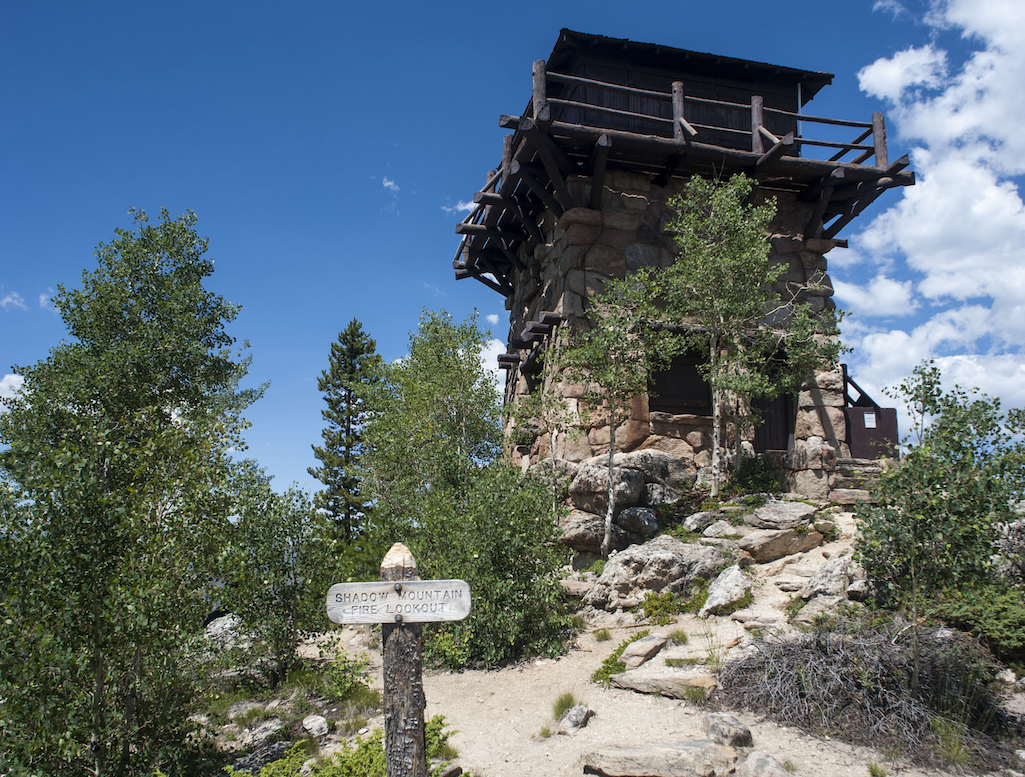
The Shadow Mountain Lookout in Rocky Mountain National Park/Patrick Cone
On the west side of Rocky Mountain National Park, where the Colorado River drains out of Shadow Mountain Lake and heads down a short course to fill Lake Granby, is a path that leads to the shoulder of Shadow Mountain. There, in an opening in the piney forest, stands a fire lookout built in 1933.
The Shadow Mountain Lookout is the only lookout remaining in this national park. According to the Forest Fire Lookout Association, this three-story lookout "was staffed in 2012 for the first time since the 1969 season after having been rehabilitated in 1982 and again in 1994-96. This building represents the type of rustic design advocated by Park Service administrators and designers."
Construction on four fire lookouts in the park began in the 1930s. Along with the Shadow Mountain facility, there were lookouts at Longs Peak, Twin Sisters Peak, and the North Fork of the Thompson River. According to papers that nominated the lookout to be listed on the National Register of Historic Places roster, "[C]onstruction of the Shadow Mountain Lookout, like all fire detection towers, was a difficult task. Its location on Shadow Mountain meant that materials, such as cement, cut boards, hardware, shingles, and glass panes, had to be packed on mules to the site. However, materials which would be too costly or impossible to move, such as stone and long logs, were obtained from local sources."
According to the nomination application, "Albert H. Good in his 1938 book, Park and Recreation Structures, felt that the Shadow Mountain Lookout was one of the best designed fire detection towers; being 'illustrative of the happy results where a masonry structure can appear to grow out of a natural rock outcrop.'"
The lookout, which was first manned in 1933, was usually occupied by a married couple that would share turns keeping watch over the nearby forested lands, but they also had other duties to perform. The seasonal rangers had contact with the public, and so became involved with public relations. For that purpose the tower's ground floor was used as a museum, which probably had exhibits on fire protection and the park's wildlife, and a visitor contact station. With the introduction of radio to the park, the lookout's personnel had to repeat messages, when necessary, between rangers at lower elevations, where trees and mountain might cause interference; and they also established contact with bordering National Forests when conditions dictated. The development of new fire policies; new methods of fire detection, such as the reporting done by public and private aircraft; and the use of modern repeater stations all contributed to the decline of fire lookouts; and after the 1968 summer season the Shadow Mountain Lookout was abandoned. -- National Park Service

Though a 10-mile roundtrip, the hike doesn't turn into a death march/Patrick Cone
To reach the lookout, you face a 10-mile roundtrip hike, one that climbs more than 1,500 feet in elevation. But it's not as daunting as that might sound. The first 1.5 miles along the East Shoreline Trail are flat, following the shore of Shadow Mountain Lake with trees that provide ample shade. The next 3.3 miles via the actual Shadow Mountain Trail to the lookout provide the bulk of the elevation gain, but it's rather easily tackled thanks to the zigs and zags the trail takes to ease the climb. At one point, there's a small stream where you can wet your hat or hankerchief to cool off.
Once you reach the top, you'll enjoy the views, but likely be disappointed that you can't climb up onto the lookout's catwalks. That's because the wooden stairs and catwalks have suffered from dry rot and are no longer safe. But that doesn't mean the lookout will remain closed forever.
"We are working on re-opening to the public in a few years," park spokesperson Kyle Patterson told me after I returned home. "Just last year the park, with support from Rocky Mountain Conservancy, completed an Historic Structure Report on the Lookout which presents both a thorough documentation and a vision for the future use of the building. That vision is to allow for visitors to hike up to and climb the stairway at the tower to the observation deck along with allowing administrative use of the lookout as a functioning fire lookout. This will be accomplished by rehabilitating the structure. Presently, we're working on finalizing the design and construction drawings to complete this rehabilitation and will soon begin seeking funding for all of the necessary repairs."
The hike down was quicker than the one up and made a little more impressive by the young black bear that ambled across the trail on an uphill tangent, moving much more easily than we were on the downhill.
Resources:
Map: Trails Illustrated No. 200, Rocky Mountain National Park
Trailhead: East Shore, accessed across the dam near the Green Ridge Campground.
Suggested gear: Mid-weight hiking shoes, broad-brimmed hat, hiking sticks, 3 liters of water, snacks, rain gear.
Fine print: From May 27 to October 10, 2022, Timed Entry Permit Reservations are required to enter most areas of Rocky Mountain National Park between 9 a.m. and 3 p.m. whether you're traveling by vehicle, bike, or hiking.

 Support Essential Coverage of Essential Places
Support Essential Coverage of Essential Places




Add comment